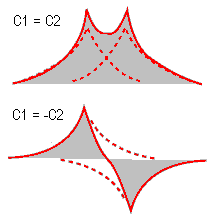This is the LCAO approximation i.e. approximating the wavefunction of a hydrogen molecule as the sum/different of the two atomic orbitals. If $\phi_A$ is the wavefunction of one hydrogen atom and $\phi_B$ the wavefunction of the other then we guess that the wavefunction of the hydrogen molecule can be approximated as:
$$ \Psi_{H_2} = C_1\phi_A + C_2\phi_B $$
where $C_1$ and $C_2$ are constants to be determined. From symmetry we know that the ground state must have $C_1$ and $C_2$ equal in magnitude, so the only possibilities are $C_1 = C_2$ and $C_1 = -C_2$. That's why we can write the two molecular wavefunctions as :
$$ \Psi_+ = C\phi_A + C\phi_B = C \left( \phi_A + \phi_B \right) $$
and:
$$ \Psi_- = C\phi_A - C\phi_B = C \left( \phi_A - \phi_B \right) $$
where I've dropped the subscript $1$ because it isn't needed. The molecular orbitals $\Psi_+$ and $\Psi_-$ look like:

To actually calculate the value of $C$ you use the fact that $\Psi$ must be normalised so:
$$ C = \frac{1}{\sqrt{2 (1 + S)}} $$
where $S$ is the overlap integral $\langle\phi_A|\phi_B\rangle$.


